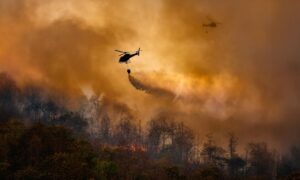Sixty percent of Canadian communities vulnerable to wildfires – report

Sixty percent of Canadian communities vulnerable to wildfires – report | Insurance Business Canada
Catastrophe & Flood
Sixty percent of Canadian communities vulnerable to wildfires – report
Insurer-backed research centre offers advice on strengthening wildfire resilience
Catastrophe & Flood
By
Mika Pangilinan
A significant portion of Canadian communities are vulnerable to wildfires amid a record year for blazes, according to the University of Waterloo’s Intact Centre of Climate Adaptation.
In a new report published on Monday, the insurer-backed climate research centre highlighted the impact brought by the fires that ravaged a total of 18.5 million hectares this year.
This is equivalent to three times the expanse of Nova Scotia and marks an eightfold increase compared to the average annual burned area over the past 25 years, the report noted.
With this level of destruction, Canada witnessed the evacuation of 200,000 residents, as well as insured losses estimated to exceed $3 billion.
“Climate change is lengthening the wildfire season, contributing to larger, more destructive wildfires, and impacting areas across Canada that historically were not regarded as wildfire-prone, such as the Halifax-area wildfire that destroyed over 200 buildings in 2023,” said Cheryl Evans, one of the report’s authors and a director at the Intact Centre.
As climate change continues to exacerbate the intensity of natural catastrophes, 60% of Canadian communities remain vulnerable to wildfires due to their close proximity to forested and grassland areas, according to the Intact Centre’s report.
The risk faced by these communities has also been compounded by expanding urban and industrial development, a lack of nationally accepted building standards to shield against wildfires, the accumulation of combustible vegetation near structures, and increased fuel in surrounding areas due to a century of fire suppression.
Strengthening wildfire resilience in Canadian communities
To help communities respond to wildfire risk, the Intact Centre compiled best practices developed by the National Research Council of Canada and FireSmart Canada, a 30-year-old national initiative operated by the Canadian Interagency Forest Fire Centre. It presented these practices as two image-based infographics outlining clear steps that homeowners can easily follow.
One of the two infographics is called Three Steps to a Cost-Effective FireSmart Home. It presents a systematic approach to fortifying homes against wildfires. Steps include simple actions like storing wood away from homes and clearing flammable shrubs around foundations, as well as more intricate measures such as installing Class A fire-rated roofing materials.
Three Features of a Wildfire-Ready Community, the second infographic, outlines directives to mitigate risks beyond individual homes. These include removing tree branches near power lines, integrating fire breaks into community planning, conducting regular emergency training sessions, and ensuring sufficient water supply for firefighting.
What are your thoughts on this story? Feel free to comment below.
Keep up with the latest news and events
Join our mailing list, it’s free!






